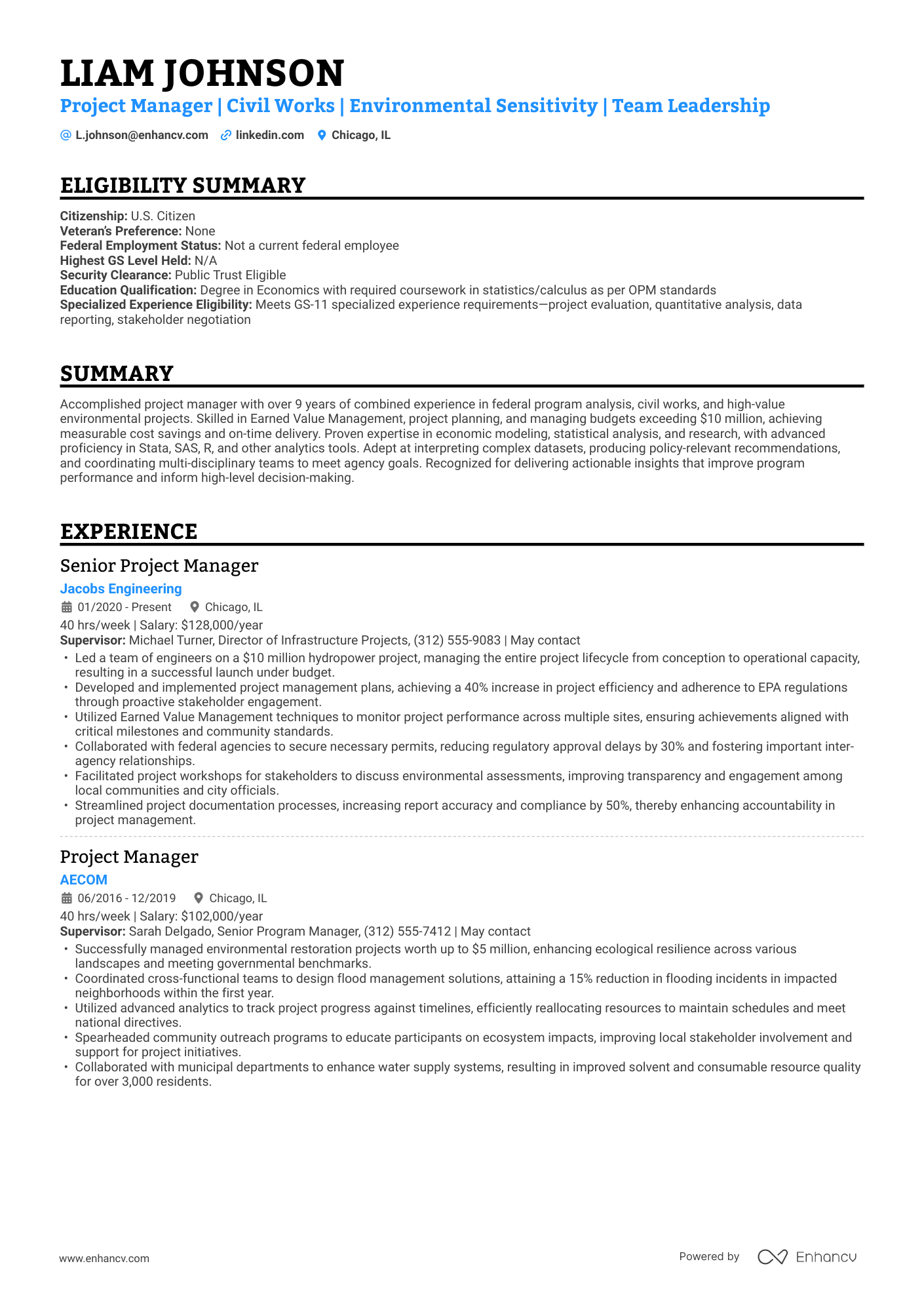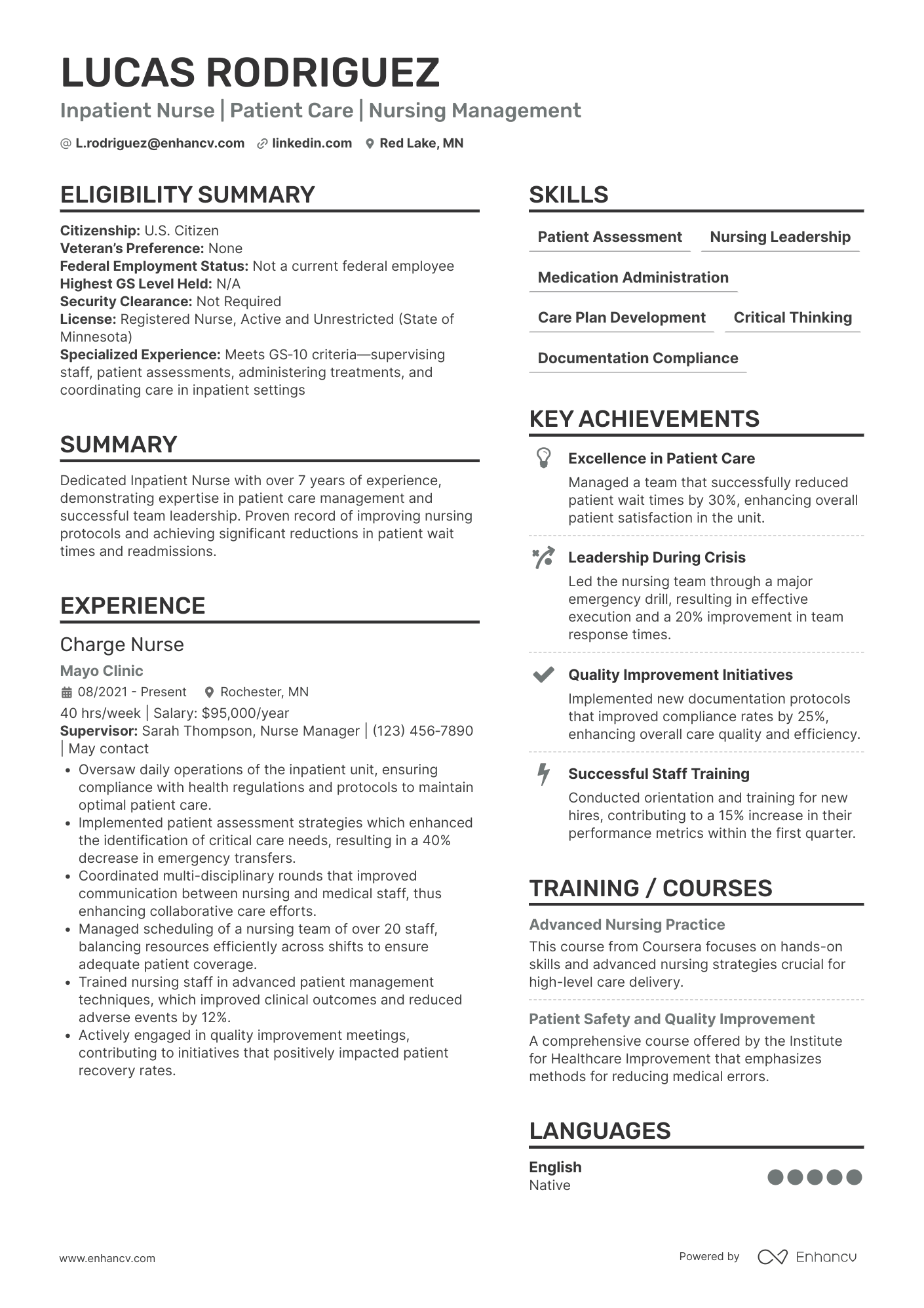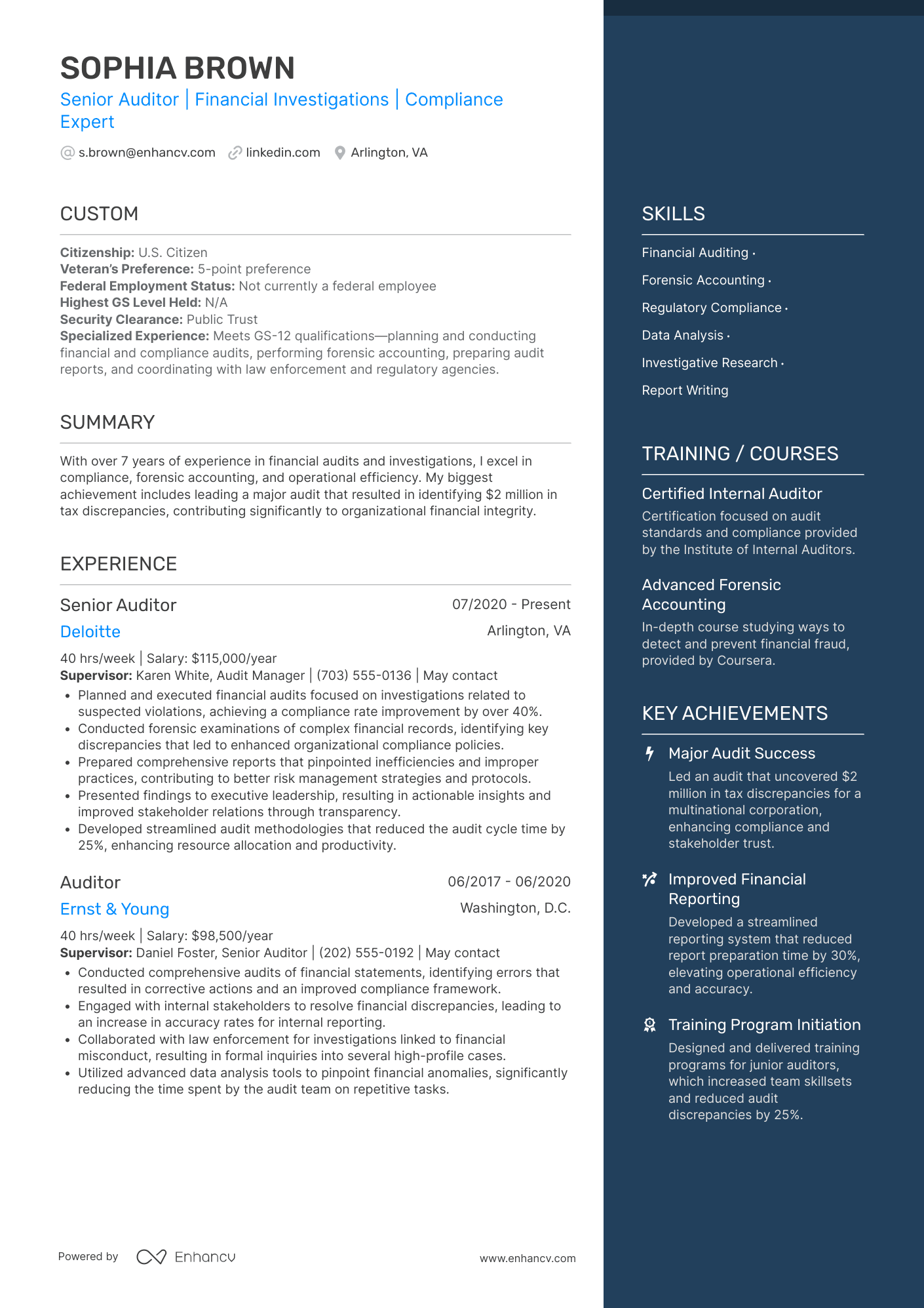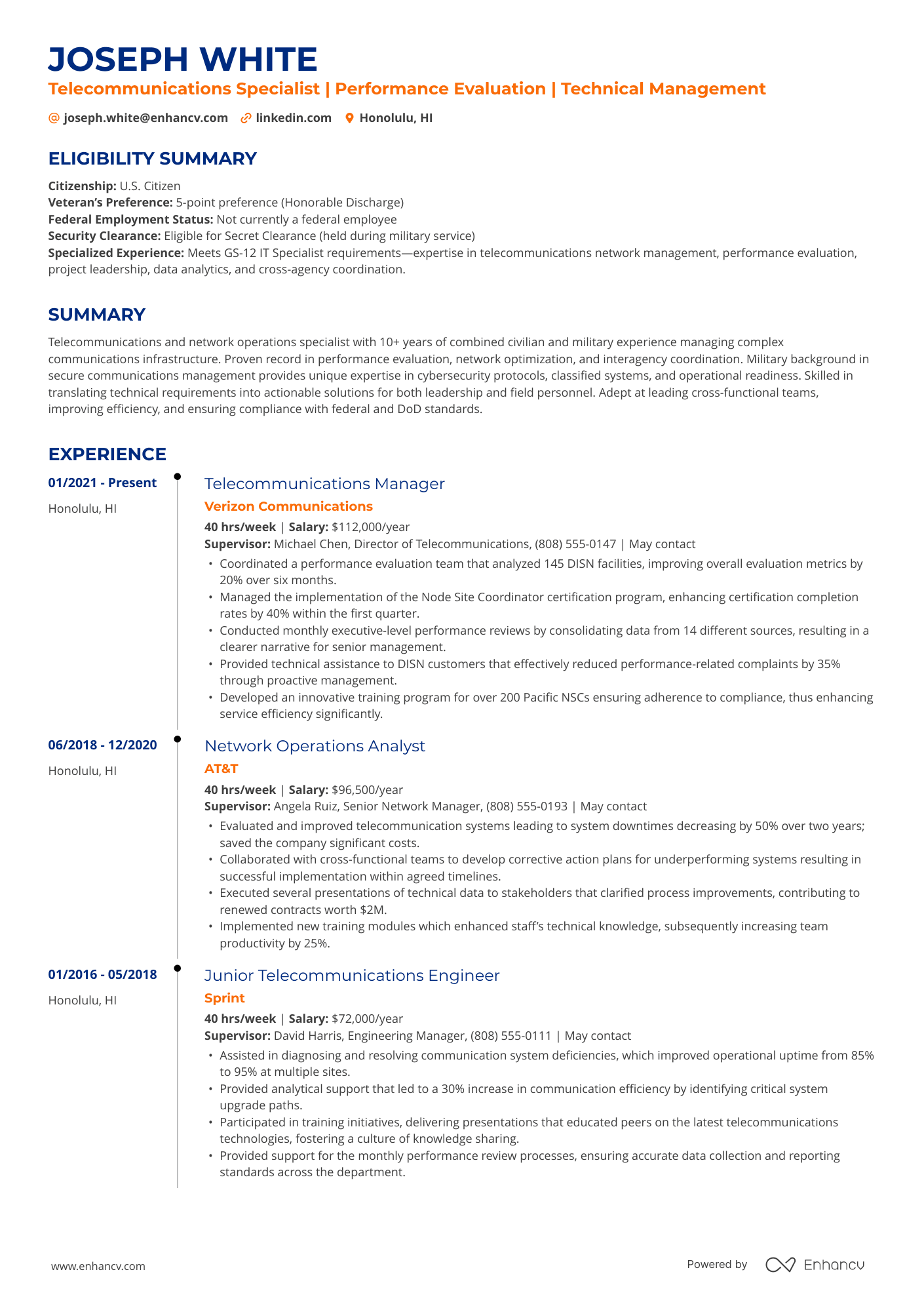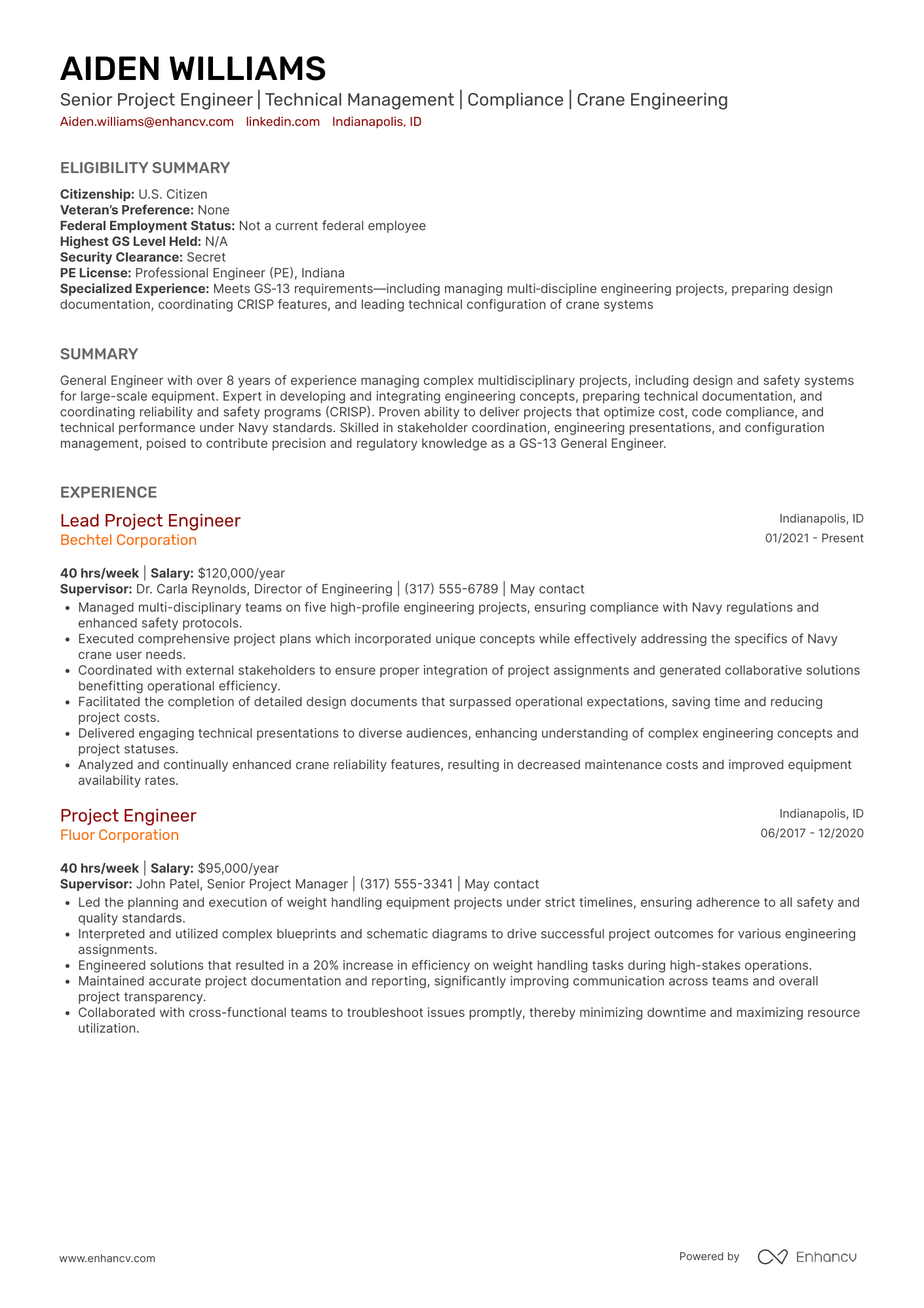Applying for a government job is like entering a different hiring universe. You’re not just sending your resume to a hiring manager—you’re submitting a detailed legal document that must meet strict requirements. Miss one, and your application might never even reach a human.
Federal government resumes aren’t just longer—they’re built for a completely different system. Instead of standing out with creativity, you need to match the job announcement word for word, justify every qualification with numbers, and follow USAJOBS.gov guidelines to the letter.
This guide walks you through exactly how to do that. It has 10 federal government resume examples, expert formatting tips, and plenty of insights to make your application stand out (in the right way).
Key takeaways
- Federal resumes are three to five (or more) pages long and must include detailed job entries with dates, hours per week, salary, and supervisor contact information.
- Use exact keywords from the job announcement, especially under “specialized experience,” to match both ATS and human review criteria.
- Tailor each resume to the specific role instead of submitting a generic version for multiple applications.
- Include volunteer work, certifications, and education that clearly support your eligibility and the job’s qualifications.
- Quantify achievements with measurable results—such as conviction rates, cost savings, or time reductions—to stand out among similarly qualified candidates.
- Follow USAJOBS.gov application instructions precisely, including file formatting, naming, and required supplemental documents.
- Break out hard and soft skills, placing them in a dedicated skills section and throughout work experience bullets to reinforce relevance.
- Avoid private-sector jargon and vague terms, ensuring your language is specific, measurable, and aligned with federal hiring standards.
Federal resume examples
By Role
Where to find federal and state government jobs
First time searching for a government job?
Federal government jobs are posted on USAJOBS.gov, while state government jobs are listed on each state’s official hiring portal.
Let’s go over the details.
For federal government jobs:
The official job board of the U.S. federal government is “USAJOBS.gov.” This platform lists thousands of open federal positions across all agencies, from entry-level to senior executive roles.
You can:
- Search by location, agency, pay grade, or keyword.
- Filter for remote jobs or those open to the public.
- Set up job alerts and save searches.
- Read detailed job announcements with qualifications and resume requirements.
Every job on USAJOBS includes a section called “How You Will Be Evaluated.” Use it as a checklist when writing your federal resume.
For state government jobs:
Each U.S. state manages its own hiring portal—for example:
Here are some of the most commonly searched:
| State | Job portal |
|---|---|
| California | CalCareers |
| Texas | StateJobsNY |
| Florida | PeopleFirst |
| Illinois | WorkIllinois |
To find openings in your state, simply Google:
[Your State] government jobs site
Example: “Washington government jobs site” → https://careers.wa.gov/
PRO TIP
Create an account on these job portals to upload your resume, set alerts, and track your applications. This streamlines the process—especially when you're applying to multiple roles over time.
And to keep things organized, be sure to use Enhancv’s AI-Powered Job Application Tracker!
One dashboard—zero guesswork. Keep your job hunt organized and stress-free.
Once you’ve found a role to apply for, the next step is building a resume that meets federal standards.
Federal resume sample
Let’s start with a real‑world example of what a successful federal resume looks like. This sample is based on a mid‑level analyst position posted through USAJobs.
Jordan Matthews
Washington, DC | (202) 555-0198 | j.matthews@email.com
Eligibility Summary
- Citizenship: U.S. Citizen
- Veteran’s Preference: None
- Federal Employment Status: Not a current federal employee
- Highest GS Level Held: N/A
- Security Clearance: Active Public Trust Clearance
- Bar Admission: New York State, Active Member in Good Standing
- Special Hiring Authorities: None
Resume Summary
Criminal prosecutor with 7 years of trial and appellate experience in federal and state courts, specializing in organized crime, narcotics, and white-collar cases. Proven track record of securing convictions in 88% of felony trials and drafting appellate briefs that led to two precedent-setting decisions. Skilled in grand jury proceedings, legal research, and interagency coordination, with a strong commitment to ethical advocacy.
Work Experience
Special Litigation Counsel
New York State Office of the Attorney General — New York, NY
07/2022 – Present | 50 hrs/week | Salary: $128,000/year
Supervisor: Linda Perez, Senior Litigation Counsel, (212) 555-0179 | May contact
- Manage complex white-collar and mortgage fraud cases totaling over $15M in alleged losses, coordinating with federal and state agencies for evidence gathering.
- Reduced average indictment processing time by 15% by implementing an electronic case management workflow.
- Train junior attorneys and interns on legal research, courtroom procedure, and ethical conflict disclosure requirements.
Assistant District Attorney
Cook County State’s Attorney’s Office — Chicago, IL
09/2016 – 06/2022 | 50 hrs/week | Salary: $98,500/year
Supervisor: Mark Johnson, Chief of Criminal Division, (312) 555-0144 | May contact
- Led over 55 felony-level prosecutions involving drug trafficking, organized crime, and child exploitation, achieving an 88% conviction rate.
- Directed investigative strategy for multi-agency operations, providing legal guidance to law enforcement that resulted in 40+ successful search warrants.
- Presented 75+ cases to grand juries, resulting in over 60 indictments.
- Drafted 20+ appellate briefs and delivered oral arguments before the Illinois Court of Appeals, with two decisions cited as precedent in subsequent cases.
Education
Juris Doctor (J.D.), Criminal Law Concentration
Georgetown University Law Center — Washington, DC
Graduation Year: 2015
- Bar Admission: New York State, Active Member in Good Standing
- Dean’s List (2014–2015), Moot Court Competition Finalist
Bachelor of Arts, Political Science
University of Virginia — Charlottesville, VA
Graduation Year: 2012
Certifications
- Active Bar License, New York State Unified Court System — 2015
- Certified eDiscovery Specialist (CEDS), ACEDS — 2019
Skills
- Legal research and writing
- Grand jury proceedings
- Criminal trial litigation
- Appellate advocacy
- Case management systems (CM/ECF, PACER)
- LexisNexis & Westlaw
- Interagency coordination
- eDiscovery tools
Now that you’ve seen an example, let’s break down how to format your federal resume step by step.
How to format a federal government resume
Formatting is critical for a federal resume, ensuring that your information is clear, complete, and easy for both hiring specialists and automated systems to review.
Here’s what you need to know:
Accepted resume format for federal jobs
- Use a reverse-chronological format with clearly labeled resume sections. Most agencies reject functional or hybrid formats.
Design, margins, and length
- Stick to classic resume fonts like Arial or Times New Roman, 10 to 12 pt.
- Avoid design elements like icons or sidebars.
- Maintain 1‑inch margins—left‑aligned content.
- Aim for three to five pages, depending on experience and job level.
Contact info
- Always include in your contact information a full name, address (city/state), phone number, professional email, LinkedIn (optional). These are a part of your resume header.
- Display citizenship, veteran status, GS level, and supervisor contact info in job entries.
- No need for a photo—federal resumes don't require or allow headshots.
- Do NOT include any sensitive information, such as your date of birth or social security number.
PRO TIP
Worried about applicant tracking systems (ATS)? Don’t be. Most federal agencies use systems that can handle fonts, colors, columns, and longer resumes without issue.
What matters more is how well your resume matches the job posting. Use the exact language from the job description—especially for qualifications and duties—and format dates clearly (e.g., MM/YYYY). Stick to simple bullet points to avoid parsing issues.
That said, not all applications are screened solely by software. Hiring managers still read resumes, so avoid keyword stuffing and keep your content clear and relevant. Focus on aligning your experience with the role, not on gaming the system.
File formatting and naming
- Download your resume as a PDF using the Enhancv Resume Builder—our templates are fully optimized for ATS and can be uploaded directly to the USAJOBS site without formatting issues.
- Use a file name like “Jordan_Matthews_Federal_Resume_2026.pdf.”
Top sections to include
The structure of your application plays a key role in how effectively your qualifications are reviewed—by both ATSs and human evaluators. In this post, we’ll break down each of the core resume sections in detail.
Follow this order to ensure your resume aligns with federal hiring expectations:
- Eligibility Summary or Applicant Information
- Summary
- Experience
- Volunteer Work
- Education
- Training and Certifications
- Skills
- Languages
- Optional: Awards, Publications
Is your resume good enough?
Drop your resume here or choose a file. PDF & DOCX only. Max 2MB file size.
Once your application is properly formatted, the next step is tailoring your resume to match the specific requirements of each federal job you apply for.
Customizing for federal jobs
Unlike private sector resumes, federal resumes are reviewed for strict qualification requirements. Agencies won't infer qualifications—you must spell them out clearly.
How to tailor your resume
- Study the job opportunity announcement (JOA) and underline every keyword in the specialized experience section.
- Match the agency's language exactly (e.g., “contract negotiation” not “vendor deals”).
- Include answers and evidence that align with the assessment questionnaire (see "Pro tip" below).
- Reflect knowledge, skills, and abilities (KSAs) with specific results in your experience bullets.
- Use action verbs and break down responsibilities using a consistent format.
PRO TIP
The assessment questionnaire on USAJOBS is a key part of the federal hiring process and often weighs as heavily as your resume. It asks you to rate your experience on specific tasks—usually using multiple-choice scales—and your answers must match the qualifications and keywords in the job announcement.
Always review the posting first, highlight those keywords, and make sure your resume clearly supports every claim you make in the questionnaire. Be accurate but confident: choose the highest truthful rating you can, and avoid underselling yourself, as unsupported or inconsistent answers can lower your score or disqualify you.
Check to see how tailored your resume is with Enhancv’s targeted resume tool for positions where formatting compliance is critical. It ensures your resume is searchable and aligned with federal expectations.
How to write your federal government resume experience
In this section, we’ll break down how to write an effective work experience section for a federal resume. Before jumping into examples, we’ll first outline the key elements that every entry should include.
Once we’ve covered what to provide, we’ll analyze a real job description taken from an official government posting. Using its language and priorities, we’ll then build a tailored work experience example that aligns with the role’s expectations.
The goal is to move beyond listing responsibilities and show how your experience meets federal standards—clearly, precisely, and with measurable impact.
What to include in your federal job experience section
- Job title and agency/organization
- Full address of the employer (city/state at a minimum)
- Dates of employment in mm/yyyy – mm/yyyy format
- Hours worked per week
- Salary (optional but often preferred)
- Supervisor’s name, contact, and whether they may be contacted
- A clear list of duties and quantifiable accomplishments
- Action verbs and keywords pulled from the job posting
Why resume tailoring matters for federal jobs
- Federal job announcements list required core competencies—mirror their language in your resume.
- Each job has a unique assessment questionnaire—your resume should support your answers.
- Keywords like “data analysis,” “contract negotiation,” or “GS‑12 budget responsibility” are essential depending on the position.
- Using exact terminology (e.g., “OMB Circular A‑11”) helps show you're familiar with federal standards.
Work experience example
Now, let’s go through a federal job advert. We’ll use this particular one to target the examples later in the article.
Assistant United States Attorney
Job Description
Employment with the U.S. Attorney's Office offers a unique and challenging experience for the highly motivated attorney. Working in the Criminal Division, you will be part of a dedicated team helping to enforce Federal criminal laws that protect life, liberty, and property. The District prosecutes the full range of federal criminal cases.
Assistant United States Attorneys in the Criminal Division are responsible for the investigation and prosecution of cases, including drugs, human trafficking, organized crime, terrorism, white collar, immigration, child exploitation, mortgage fraud and general crime. The successful applicant will be responsible for all phases of criminal prosecution to enforce federal laws, including providing guidance to law enforcement officers, initiating criminal charges, conducting grand jury proceedings and felony trials, and handling appeals.
Responsibilities will increase and assignments will become more complex as your training and experience progress.
Qualifications
The District seeks attorneys who have outstanding legal ability, high moral character, mature judgment, and demonstrated excellence in criminal trials. Applicants must possess a J.D. degree (or equivalent), be an active member in good standing of the bar (any U.S. jurisdiction), and have at least one year post-J.D. (or equivalent) legal or other relevant experience. A minimum of two years of post-J.D. (or equivalent) legal or other relevant experience is required.
Preferred Qualifications: The ideal candidate will have (1) legal practice and trial experience related to criminal prosecution; (2) quick analytical ability and the facility to accurately and precisely articulate the critical issues involved with a case; (3) superior oral, trial, and writing skills, as well as strong research and interpersonal skills; (4) ability to work in a supportive and professional manner with the court, other attorneys, support staff and client agencies; (5) capacity to function with minimal guidance in a highly demanding litigative environment; and (6) excellent computer literacy skills to include experience with automated research, electronic court filing, electronic e-mail and word processing systems.
“Political Appointees (Current or Former): The Office of Personnel Management (OPM) must authorize employment offers made to current or former political appointees. If you are currently, or have been within the last 5 years, a political Schedule A, Schedule C, or Non-Career SES employee in the Executive Branch, you must disclose this information to the HR Office. Failure to disclose this information could result in disciplinary action, including removal from Federal Service.”
Application Process
To apply for this position, you must complete an online occupational questionnaire and submit the documentation specified below. Applications can be submitted online through the following link: 25-NYW-12715506-AUSA
The announcement will remain open until filled. If unable to apply online, the announcement provides instructions on faxing your documents in the "How to Apply" tab.
Applicants should familiarize themselves and comply with the relevant rules of professional conduct regarding any possible conflicts of interest in connection with their applications. In particular, please notify this Office if you currently represent clients or adjudicate matters in which this Office is involved and/or you have a family member who is representing clients or adjudicating matters in which this Office is involved so that we can evaluate any potential conflicts of interest or disqualification issues that may need to be addressed under those circumstances.
How to approach a complex federal government job posting
Federal job ads, especially those for high-level roles like Assistant U.S. Attorney, can feel overwhelming. They're dense, formal, and packed with legal or procedural language.
Here's how to break them down and extract what matters:
| Best practice | Description |
|---|---|
| Start with the scope of the role | Focus on the first two paragraphs under "Job Description" to understand what you’ll actually do. Identify the day-to-day responsibilities, legal areas involved, and the types of cases or projects you’ll handle. |
| Pay close attention to qualifications—especially experience | Federal listings often repeat or layer experience requirements. Look for hard cutoffs (e.g., “minimum of two years post-J.D.”) and compare them with preferred qualifications, which can hint at what makes a competitive candidate. |
| Use the language of the ad in your resume | Extract keywords and phrasing—like “guidance to law enforcement officers” or “superior oral, trial, and writing skills”—and echo them in your accomplishments. This aligns your resume with ATSs and human readers alike. |
| Spot procedural red flags | Sections like the one on “Political Appointees” or “Conflict of Interest” aren’t just legal formalities—they’re compliance checkpoints. If you’re affected, don’t skip over them. Disclosures are mandatory and not submitting them could disqualify you. |
| Don’t skip the application mechanics | Federal jobs often require uploading documents in a specific way or format. Read the “How to Apply” instructions in full. Missing a required form or failing to complete the questionnaire can delay or void your application. |
Take a moment to digest all that, and when you’re ready, let’s dive into a practical example of an entry tailored to the above job.
Assistant district attorney
- •Prosecuted 55+ felony-level cases involving narcotics, organized crime, child exploitation, and mortgage fraud, achieving an 88% conviction rate in jury trials.
- •Directed investigative strategy for joint task forces, including a terrorism case that secured four federal indictments through coordinated law enforcement action.
- •Presented 75+ cases to grand juries, resulting in over 60 indictments supported by detailed evidentiary records.
- •Drafted and argued 20+ appellate briefs before the Illinois Court of Appeals, securing three decisions now cited as controlling precedent.
- •Maintained exemplary ethical standards while collaborating with judges, law enforcement, victim advocates, and defense counsel to uphold fair trial practices.
- •Managed multi-million-dollar white-collar and mortgage fraud investigations, including a $9.3M federal case involving cross-border evidence recovery.
- •Developed litigation strategy with federal client agencies, applying rapid statutory analysis and expert-level trial preparation.
- •Delivered oral arguments in complex cases before federal and state courts, consistently earning commendations for precision and persuasive impact.
- •Trained and mentored junior attorneys and interns in electronic court filing, advanced legal research, and conflict-of-interest compliance.
- •Maintained high-volume litigation workload in a time-sensitive environment, balancing trial work, motions practice, and policy advisory duties without direct supervision.
Here’s how each part of the sample work experience entries directly targets core elements of the federal job posting:
- Demonstrated full prosecutorial scope, from initiating charges and presenting to grand juries to conducting felony trials and appeals.
- Showed subject-matter expertise through prosecutions involving drug trafficking, organized crime, terrorism, and mortgage fraud.
- Provided legal guidance to law enforcement and coordinated with federal agencies during complex investigations.
- Highlighted strong communication, ethical conduct, and independent decision-making in high-pressure, low-supervision environments.
Once you've structured your experience correctly, the next step is to focus on highlighting your accomplishments within each role.
Highlighting accomplishments and experience
Federal agencies rely on quantifiable data to assess how well you’ve performed—not just what you were responsible for. Every job posting outlines specialized experience, and your resume must prove you’ve applied it in measurable, impactful ways.
How to showcase impact
- Use bulleted lists to emphasize achievements rather than duties.
- Include stats, percentages, and tangible results.
- Highlight experience with community organizations or volunteer work—especially if it shows leadership or subject-matter knowledge.
- Provide letters of recommendation or performance reviews if the agency accepts them.
- Note any roles as a project manager or on subject-matter expert teams.
Sample accomplishments
"Improved reporting accuracy by 25% through automated audit logs."
"Reduced data collection cycle from 45 to 30 days by optimizing stakeholder workflow."
"Led usability testing for a new agency portal that improved satisfaction scores by 32%."
The first thing we need to look at, if this is your first time applying for a federal job, is understanding where the job application process happens—USAJOBS.
How to navigate USAJOBS: a quick guide for first-time federal applicants
USAJOBS.gov is the official job portal for federal government positions. It hosts thousands of listings across all agencies and roles—but it’s not always easy to use. Here’s how to approach it with focus and efficiency.
1. Create a complete profile
Before applying, build a full profile with your contact details, citizenship status, and work eligibility. Use the resume builder if needed, but uploading a PDF that meets federal formatting standards is often better.
2. Use advanced search filters
Basic searches return overwhelming results.
Use filters like:
- Agency (e.g., Department of Justice)
- Job series (e.g., 0905 for attorney)
- Pay grade (GS level) to target jobs that match your experience
- Remote/In-person and location
- Security clearance if applicable
You can also save your filters and turn on job alerts for real-time updates.
3. Read job announcements carefully
Federal listings are detailed for a reason.
Focus on these sections:
- Duties and qualifications: These show what to mirror in your resume.
- Conditions of employment: Citizenship, background checks, or travel requirements.
- Required documents: Often more than just a resume—transcripts, SF-50s, or cover letters may be needed.
Drop your resume here or choose a file.
PDF & DOCX only. Max 2MB file size.
4. Customize every application
One resume doesn’t fit all. Match your accomplishments to the keywords and phrases in the job description. Use the same language. Federal hiring often uses checklists and automated scoring.
5. Track applications in your dashboard
After applying, your USAJOBS dashboard will show each job's status. Terms like “Received,” “Reviewed,” and “Referred” indicate where your application stands in the process. This may take several weeks.
6. Don’t ignore the questionnaire
Most listings include an occupational questionnaire. Answer honestly but confidently. Many applicants get filtered out based on this step alone.
7. Be patient—and persistent
Federal hiring takes time. Some roles close within days, while others stay open for months. Always double-check closing dates and save copies of everything you submit.
Once you understand how to find federal jobs, the next step is learning how to apply—especially if you’re starting with little or no experience.
How do I write a federal resume with no experience?
Even if you don’t have direct federal experience, you can still write a strong resume. Focus on transferable skills, relevant achievements, and aligning your background with the job’s core requirements.
Many of positions you can find on USAJOBS that don’t require experience are mostly internships and/or other unpaid positions, such as for the Peace Corps or AmeriCorps.
What to include if you don’t have work experience
- Professional summary or objective
- Education section with GPA, coursework, and credit hours
- Volunteer work and internships
- Course projects and research
- Skills and languages aligned to the posting
- Certifications or licenses
- Awards or distinctions
Strong objective example
If you lack direct experience, a resume objective lets you clearly state your goals, show enthusiasm for the role, and highlight transferable skills. It should name the position, reference one or two strengths, and connect your interest to the agency’s mission.
Once you’ve landed your first role, the next step is showing how you’ve grown and advanced over time.
How to show career progression on a federal government resume
A federal resume should show not just where you’ve worked, but how your responsibilities and impact have grown—especially if you're trying to move up in your career.
Tips to show federal career progression
- Emphasize increased responsibility.
- Highlight supervisory duties.
- Note promotions within the same agency.
- Show how your projects grew in scale or complexity.
- Use phrases like “selected to lead,” “appointed by,” and “promoted to.”
- List training programs or leadership development.
Common career paths before advancement
- GS‑12 Program Analyst → Management Analyst, Budget Analyst
- GS‑13 Contracting Officer → Procurement Analyst, Contract Specialist
- GS‑14 Policy Advisor → Senior Analyst, Communications Lead
To show how far you’ve come, you also need to highlight the skills that helped you get there.
How to list your hard and soft skills on a federal resume
Skills on a resume matter because they help hiring managers quickly see whether you meet the technical skills and interpersonal requirements of the role.
Hard skills are measurable abilities—like legal research, case management, or knowledge of federal procedures. Soft skills are behavioral—like communication, judgment, or adaptability. Both are important, especially in roles where collaboration, independence, and attention to detail are key.
You can include your skills in three main places:
- In a dedicated skills section near the top.
- Throughout your work experience bullet points.
- In your resume summary or objective, if you’re new to the field.
Prioritize skills listed in the job announcement and back them up with examples wherever possible.
Here are some prime examples.
Best hard skills for your federal resume
- Microsoft Word
- Microsoft Excel
- Microsoft Outlook
- Adobe Acrobat Pro
- LexisNexis
- Westlaw
- CaseMap
- Relativity
- Concordance
- CM/ECF (Case Management/Electronic Case Files)
- PACER (Public Access to Court Electronic Records)
- SharePoint
- eDiscovery tools
- FOIAonline
- HRConnect
- USA Staffing
- Tableau
- Power BI
- SQL
- ArcGIS
Best soft skills for your federal resume
- Communication
- Analytical thinking
- Attention to detail
- Time management
- Problem-solving
- Adaptability
- Teamwork
- Leadership
- Decision-making
- Integrity
- Accountability
- Collaboration
- Critical thinking
- Initiative
- Conflict resolution
- Dependability
- Organizational skills
- Judgment
- Interpersonal skills
- Resilience
Once you’ve highlighted your key skills, the next step is to show the credentials that support them—your certifications and education.
How to list your certifications and education on a federal resume
Your education section and certifications show you meet the formal requirements for a federal role and have the credentials to support your skills. For many positions—especially those requiring professional licenses or advanced degrees—this section can be the deciding factor in whether your application advances.
What to include in an education entry
A complete education entry should list:
- Degree name and field of study
- Institution name
- Location (city, state)
- Coursework (if relevant)
- Graduation year (month is optional and usually omitted)
- Honors or distinctions (e.g., Dean's list, cum laude)
- GPA (only if notable and recent)
For certifications, list:
- Certification name
- Issuing organization
- Year earned
- Credential ID or URL (if applicable)
PRO TIP
You can find more on official education and credential requirements for federal jobs at the USAJOBS Help Center – Education.
Targeting the example to the job ad
The Assistant United States Attorney role specifies a J.D. degree and bar membership in good standing as mandatory. In this case, the education section should clearly highlight the law degree, the law school’s location, the graduation year, and bar admission details.
If applicable, include specialized coursework, moot court experience, or academic honors relevant to federal criminal law.
- •Bar Admission: New York State, Active Member in Good Standing
- •Dean’s List, Moot Court Competition Finalist
- •Completed advanced coursework in Federal Criminal Procedure and Evidence
Why it’s good:
- Clearly named the degree, concentration, and institution, making the qualification easy to identify.
- Included graduation year only, keeping the entry clean and avoiding unnecessary detail.
- Added bar admission and status directly under the degree to emphasize meeting mandatory requirements from the job ad.
- Featured honors and relevant coursework to strengthen alignment with the role’s criminal law focus.
- Used a concise, structured format that is easy for both hiring managers and applicant tracking systems to scan.
Best certifications for your federal resume
With your education and certifications clearly outlined, the next step is to craft a strong federal resume summary that quickly connects your qualifications to the role.
What is an eligibility summary and why you need one
This section is located just below your header and above your resume summary acts as a quick-reference snapshot for HR specialists before they read the rest of your resume. Federal hiring often involves strict legal and procedural criteria, so clearly stating your eligibility factors helps ensure your application isn’t set aside for missing information.
What it usually includes
- Citizenship status (e.g., “U.S. Citizen”)
- Veteran’s preference (if applicable)
- Federal employment status (e.g., current federal employee, reinstatement eligible)
- Security clearance (if you hold one)
- Highest General Schedule (GS) level held
- Special hiring authorities (e.g., Schedule A for persons with disabilities, Pathways Program eligibility)
Why it matters
- Federal HR specialists often must verify eligibility before even reviewing your qualifications.
- Missing or incomplete applicant information can lead to immediate disqualification, even if you’re otherwise well qualified.
- Having this at the top of your resume speeds up review and shows you understand federal application expectations.
How to write your federal resume summary
Your federal resume summary is the first thing a hiring manager or HR specialist will read, making it one of the most important parts of your application. Its purpose is to quickly connect your background to the job requirements and make a clear case for why you should advance to the next stage.
A strong summary for a federal government role should:
- Identify your professional title or area of expertise.
- Show alignment with the agency’s mission or priorities.
- Highlight your most relevant skills and experience.
- Quantify achievements to demonstrate measurable impact.
- Convey both technical and interpersonal strengths.
This section isn’t just a restatement of your resume—it’s a focused, high-impact pitch that should make the reader want to learn more about you.
This summary works well because it directly mirrors the job ad’s core requirements—criminal prosecution, trial and appellate work, and collaboration with law enforcement—while backing each claim with specific, quantifiable results.
The language is concise yet impactful, making it easy for both HR specialists and automated systems to quickly recognize the candidate’s relevance.
Optimize your resume summary and objective for ATS
Drop your resume here or choose a file.
PDF & DOCX only. Max 2MB file size.
Once your core sections are complete, you can add optional sections that strengthen your application and highlight qualifications that don’t fit neatly elsewhere.
Additional sections for a federal government resume
Optional sections can highlight qualifications, experience, or contributions that don’t fit neatly under work history or education. For a role like Assistant United States Attorney, these sections can showcase specialized expertise, community involvement, or distinctions that set you apart from equally qualified candidates.
Recommended additional sections:
- Publications: List authored legal articles, case analyses, or scholarly papers related to criminal law or federal prosecution.
- Professional affiliations: Include memberships in organizations such as the American Bar Association or the National District Attorneys Association.
- Honors and awards: Highlight recognition like trial advocacy awards or commendations from law enforcement agencies.
- Volunteer experience(If you have it, use it): Show pro bono work or legal aid service that aligns with the Department of Justice’s mission.
- Languages: List additional languages spoken fluently, especially those valuable in federal investigations or court proceedings.
- Specialized training: Include advanced certifications or training such as National Advocacy Center programs or eDiscovery workshops.
With your resume content and structure finalized, it’s time to focus on how you apply. Avoid common mistakes and follow best practices that can make the difference in a competitive federal hiring process.
Application tips and common mistakes
Even the strongest federal resume can fall short if the application process isn’t handled correctly. This section will cover proven strategies to strengthen your submission and highlight the avoidable missteps that could delay—or derail—your chances of moving forward.
Checklist before submitting
- Resume contains all required sections (Summary, Experience, Education, etc.).
- Experience bullets reflect measurable results.
- Specialized experience is clearly tied to keywords from the job announcement.
- All date ranges and hours per week are included.
- Supervisor names and contact permissions are listed.
- File name and structure comply with application instructions.
Common errors
- Missing a specialized experience section or failing to match the job language exactly.
- Inconsistent formatting, such as date formats and bullet types.
- Using military abbreviations without explanation.
- Including private-sector jargon or vague terms.
- Forgetting to upload required supporting documents (transcripts, certifications, etc.).
Additional resources and special considerations
Crafting a strong federal resume doesn’t end with your work history and education. Agencies often require supplemental documentation, especially when verifying eligibility, showcasing specialized experience and education, or reviewing applications from veterans, students, and underrepresented groups.
Required supplemental materials
- Transcripts: Essential when applying to jobs with degree or credit hour requirements.
- Curriculum Vitae (CV): Used in research, scientific, or academic roles instead of a resume.
- Letters of recommendation: Occasionally requested for leadership or senior-level positions.
- Writing samples: Particularly for policy, analyst, or communications roles.
- Performance reviews: May help support supervisory experience and level of responsibility.
Considerations for special applicant groups
- Veterans and military spouses: Must include documentation for eligibility requirements, such as DD‑214, SF‑15, or SF‑50 forms. Federal roles often provide preference points or hiring pathways.
- People with disabilities: Applicants eligible under Schedule A should upload proof of disability and a referral letter.
- Federal employees: May need to verify supervisory responsibilities, grade level, or time-in-grade eligibility.
- Recent graduates and students: Should detail internships, academic projects, and course loads that meet specialized experience and education thresholds.
Editorial and application tools
- Refer to internal content strategy guidelines if using a resume builder or a professional writing service.
- Follow voice and tone particulars common to government communications: factual, direct, and respectful.
- Consider a second opinion from HR experts or use structured assessment questionnaires and checklists to validate your readiness.
External resources worth bookmarking
- USAJobs Resume Help Center
- National Archives Federal Resume Guide (PDF)
- Federal Resume Guidebook by Kathryn Troutman
- Feds Hire Vets Toolkit: Especially useful for transitioning military service members
- Schedule A hiring authority for people with disabilities
Conclusion
Creating a federal resume isn’t about standing out—it’s about meeting the job requirements exactly. Whether you’re an experienced GS-13 specialist or a first-time applicant, your resume must follow the correct structure, include measurable achievements, and align with every keyword in the job announcement.
Use this guide to build a compliant, compelling federal government resume that gets seen—and seriously considered.
